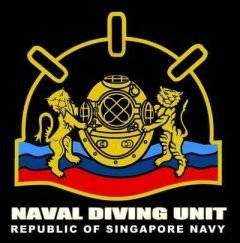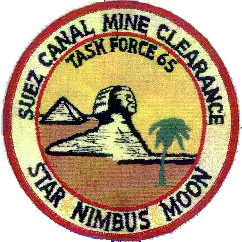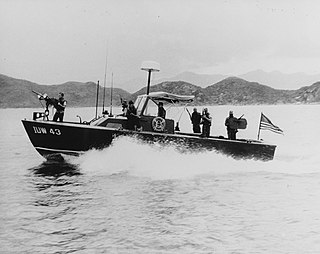Related Research Articles

A frogman is someone who is trained in scuba diving or swimming underwater in a tactical capacity that includes military, and in some European countries, police work. Such personnel are also known by the more formal names of combat diver, combatant diver, or combat swimmer. The word frogman first arose in the stage name The Fearless Frogman of Paul Boyton in the 1870s and later was claimed by John Spence, an enlisted member of the U.S. Navy and member of the OSS Maritime Unit, to have been applied to him while he was training in a green waterproof suit.

The Clearance Diving Branch is the specialist diving unit of the Royal Australian Navy (RAN) whose versatile role covers all spheres of military diving, and includes explosive ordnance disposal and maritime counter-terrorism. The Branch has evolved from traditional maritime diving, and explosive ordnance disposal, to include a special operations focus.

The United States Naval Special Warfare Command (USNSWC), also known as, is the naval component of United States Special Operations Command, the unified command responsible for overseeing and conducting the nation's special operations and missions.

In the Vietnam War, the Mobile Riverine Force (MRF) (after May 1967), initially designated Mekong Delta Mobile Afloat Force, and later the Riverines, were a joint US Army and US Navy force that comprised a substantial part of the brown-water navy. It was modeled after lessons learned by the French experience in the First Indochina War of Dinassaut and had the task of both transport (of soldiers and equipment) and combat. The primary base was at Đồng Tâm Base Camp, with a floating base at the base of the Mekong River. It played a key role in the Tet Offensive.

The Naval Diving Unit (NDU), also referred to as the Naval Divers, is the special forces formation of the Republic of Singapore Navy (RSN) responsible for conducting special operations from sea, air, and land. The formation is made up of six squadrons, specialising in explosive ordnance disposal, underwater demolition, maritime security operations, and combatant craft operations.

A clearance diver was originally a specialist naval diver who used explosives underwater to remove obstructions to make harbours and shipping channels safe to navigate, but the term "clearance diver" was later used to include other naval underwater work. Units of clearance divers were first formed during and after World War II to clear ports and harbours in the Mediterranean and Northern Europe of unexploded ordnance and shipwrecks and booby traps laid by the Germans.

United States Navy Explosive Ordnance Disposal technicians render safe all types of ordnance, including improvised, chemical, biological, and nuclear. They perform land and underwater location, identification, render-safe, and recovery of foreign and domestic ordnance. They conduct demolition of hazardous munitions, pyrotechnics, and retrograde explosives using detonation and burning techniques. They forward deploy and fully integrate with the various Combatant Commanders, Special Operations Forces (SOF), and various warfare units within the Navy, Marine Corps, Air Force and Army. They are also called upon to support military and civilian law enforcement agencies, as well as the Secret Service.

A United States Navy diver refers to a service personnel that may be a restricted fleet line officer, civil engineer corps (CEC) officer, Medical Corps officer, or an enlisted who is qualified in underwater diving and salvage. Navy divers serve with fleet diving detachments and in research and development. Some of the mission areas of the Navy diver include: marine salvage, harbor clearance, underwater ship husbandry and repair, submarine rescue, saturation diving, experimental diving, underwater construction and welding, as well as serving as technical experts to the Navy SEALs, Marine Corps, and Navy EOD diving commands.

Minentaucher is the German term for mine clearance divers. The Minentaucherkompanie is a specialist unit within the German Navy responsible for underwater tasks including removing or salvaging underwater munitions such as mines and for servicing underwater drones. It is part of the Sea Battalion and is based in Eckernförde.

Navy Expeditionary Combat Command (NECC) serves as the single functional command to centrally manage current and future readiness, resources, manning, training and equipping of the United States Navy's 21,000 expeditionary forces who are currently serving in every theater of operation. The NECC was established in January 2006. NECC is a subordinate command of the Navy's Fleet Forces Command.

USS Preserver (ARS-8) was a Diver-class rescue and salvage ship commissioned by the U.S. Navy for service in World War II. She was responsible for coming to the aid of stricken vessels.

USS Current (ARS-22) was a Diver-class rescue and salvage ship commissioned by the U.S. Navy during World War II. Her task was to come to the aid of stricken vessels.
USS Valve (ARS-28) was a Diver-class rescue and salvage ship commissioned by the U.S. Navy during World War II. Her task was to come to the aid of stricken vessels.
Salvage diving is the diving work associated with the recovery of all or part of ships, their cargoes, aircraft, and other vehicles and structures which have sunk or fallen into water. In the case of ships it may also refer to repair work done to make an abandoned or distressed but still floating vessel more suitable for towing or propulsion under its own power. The recreational/technical activity known as wreck diving is generally not considered salvage work, though some recovery of artifacts may be done by recreational divers.

The US employs divers in several branches of the armed forces, including the navy, army, marines, air force and coast guard.

Army engineer divers are members of national armies who are trained to undertake reconnaissance, demolition, and salvage tasks underwater. These divers have similar skills and qualifications as professional divers. In the United States Army, they are members of the Corps of Engineers. In the British Army they may be Royal Engineer Divers or Commando Engineer Divers.

Following the Yom Kippur War between Egypt and Israel in 1973, an international agreement was reached in October 1973 to provide measures to reopen the Suez Canal after its closure for 8 years after the 1967 Six-Day War. The U.S.-led clearing effort undertaken in 1974 consisted of three operations: the sweeping of mines in the Suez Canal by naval units from the United States, the United Kingdom and France, the provision of training and advisory assistance for land and water explosive ordnance clearance for Egyptian forces and the removal and salvage of wrecks from the Canal.

Underwater Construction Teams (UCT) are the United States Navy Seabees' underwater construction units numbered 1 and 2 that were created in 1974. A team is composed of divers qualified in both underwater construction and underwater demolition. Possible tasks can be: battle damage repairs, structural inspections and assessments, demolition of waterline facilities or submerged obstructions, installation of submerged surveillance systems, or harbor and channel clearance. As needed, teams may test and or evaluate new or existing aquatic systems or equipment. Extending construction, whether vertical or horizontal, beyond the shoreline and waterline is their specialty. Reflecting Seabee tradition, teams are expected to execute underwater construction anywhere, anytime, under any conditions.

Operation Stable Door was the United States Navy and Royal Australian Navy's harbor defense operation during the Vietnam War. This operation complemented Operation Market Time designed to prevent infiltration along the South Vietnamese coast.
References
- ↑ Bartholomew, Charles (1990). Mud, Muscle, And Miracles: Marine Salvage in the United States Navy. U.S. Government Printing Office. p. 263. ISBN 978-0-945274-60-5 . Retrieved 9 September 2014.
- ↑ Stephen Schwartz (October 20, 1997). "Remembering Vietnam's Forgotten Seamen". San Francisco Chronicle.
- ↑ "Red Mines Sink U.S. Dredge in Vietnam". Reading Eagle. UPI. Retrieved 17 September 2014.
one of the world's largest dredges . . . the 170-foot dredge Jamaica Bay
- ↑ "MDSU-1 Celebrates 46th Birthday". Ho'okele Navigator. Pearl Harbor - Hickam News. February 18, 2012. Retrieved 12 September 2014.
- ↑ US Navy Diving Manual Rev. 6 with Change A entered (PDF). U.S. Government Printing Office. 15 October 2011. pp. 1–6.2. Archived from the original (PDF) on 10 December 2014. Retrieved 9 September 2014.
 This article incorporates text from this source, which is in the public domain .
This article incorporates text from this source, which is in the public domain . - ↑ "Diver Training" (PDF). All Hands. Bureau of Naval Personnel (652): 22–23. May 1971. Retrieved 13 September 2014.
- ↑ "NavSource Online: Service Ship Photo Archive". navsource.org. 5 April 2013. Retrieved 11 October 2022.
- ↑ "You Don't See Many Like the AHLC Twins" (PDF). All Hands. Bureau of Naval Personnel (609): 16–17. October 1967. Retrieved 13 September 2014.